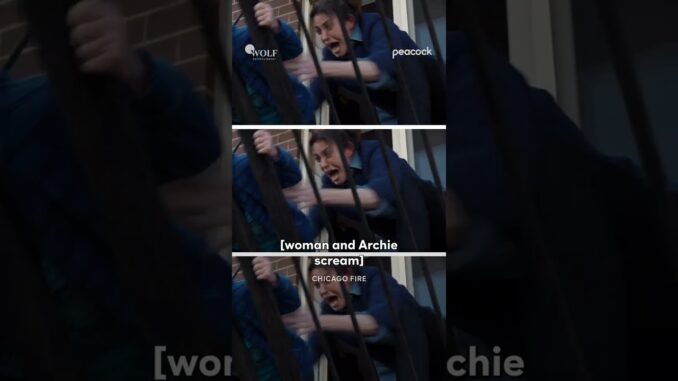
The Precipice of Innocence: A Shocking Moment in Chicago Fire
In the sprawling, high-octane universe of Chicago Fire, where heroism is a daily wage and the line between life and death is razor-thin, certain moments transcend mere plot points to become indelible scars on the viewer's memory. Among these, few are as viscerally shocking, as emotionally resonant, and as powerfully illustrative of the show's core themes as the terrifying incident where a young boy finds his head inextricably stuck in a railing that is, horrifyingly, on the verge of collapse. This isn't just a scene; it's a masterclass in suspense, a stark reminder of life's fragility, and a potent testament to the calm under pressure that defines Firehouse 51.
The scene unfolds with deceptive innocence. A seemingly innocuous afternoon, perhaps a child's curious exploration in an old building, or a moment of playful distraction in an ill-maintained structure. The setting itself, often a forgotten corner of Chicago's urban landscape – a derelict construction site, an aging apartment building, a rooftop garden teetering on the edge of disrepair – subtly amplifies the underlying tension. It speaks of the everyday dangers hidden in plain sight, far removed from the dramatic infernos and crumpled car wrecks that usually demand the firefighters' attention.
Then, the sickening thud. A child, small and vulnerable, has, in a moment of youthful exuberance or simple misjudgment, pushed his head through the gaps of an ornate, wrought-iron railing. The initial shock is not of injury, but of entrapment. A chilling clunk, a desperate wriggle, and the realization dawns, first on the child, then on frantic parents, that the small head is wedged inextricably, like a bizarre, terrible lock. This initial predicament, while terrifying, is swiftly compounded by the truly shocking twist: the very railing that holds him prisoner begins to give way.
A low, guttural creak echoes the boy’s rising terror. Dust motes dance in the harsh light as rivets groan and metal warps. The railing, once a boundary of safety, transforms into a precipice, vibrating precariously over a dizzying drop. The height is crucial here – whether it's several stories above a concrete alley or an elevated platform over treacherous machinery, the visual of empty space yawning beneath the child amplifies the terror a hundredfold. This is the moment the breath catches in the viewer's throat. The simple entrapment has escalated into a race against gravity and time, a shocking illustration of how quickly ordinary life can pivot into unimaginable peril.
As the familiar roar of Engine 51 or Ambulance 61 heralds their arrival, the chaos is palpable. Frantic parents scream warnings, the child sobs, eyes wide with incomprehension and fear, and the railing lets out another ominous groan. Into this maelstrom steps a firefighter, often Severide, whose calm demeanor and quick, assessing gaze cut through the hysteria. He is not just looking at a boy stuck in metal; he is calculating physics, estimating decay, and mapping out a rescue plan in milliseconds. The camera work in these moments is masterful, often a close-up on the child’s terrified face, then a sweeping shot down to the perilous drop, followed by the firefighter’s focused, determined expression.
The ensuing rescue attempt is a ballet of controlled urgency. There’s the delicate balance of reassuring the terrified child without causing him to panic and jostle the fragile structure further. There’s the meticulous, almost surgical application of tools – the jaws of life or specialized cutting equipment, designed for brute force but here used with surgical precision to sever just enough metal without jarring the boy or the collapsing railing. Every second stretches, a taut wire humming with impending disaster. The team works in silent synchronicity, one holding the railing steady, another bracing the child, the rescuer meticulously cutting, twisting, or prying. The true shock lies not just in the initial horror, but in the sustained, agonizing tension of this high-stakes extraction, where a millimeter wrong, a moment of lost concentration, could spell catastrophe.
When the boy is finally freed, a raw, guttural sob of relief escapes not just the parents, but the firefighters and, vicariously, every viewer. He is pulled back into safety, often held close by his rescuer, safe but irrevocably shaken. This wasn’t merely a plot device; it was a visceral reminder of the random, brutal nature of accidents, and the unsung heroism that confronts them.
The shocking moment of the boy caught in the collapsing railing is illustrative on multiple levels. It highlights the show’s commitment to grounding its drama in realistic, albeit heightened, scenarios. It showcases the diverse challenges firefighters face, extending far beyond putting out fires. Most importantly, it underscores the quiet heroism etched into the very fabric of Firehouse 51 – the ability to remain calm under the most intense pressure, to think critically when lives hang in the balance, and to dedicate themselves utterly to the preservation of life, no matter how dire the circumstances. It's a scene that lingers, a powerful testament to the show's ability to shock, move, and ultimately, deeply impress.
